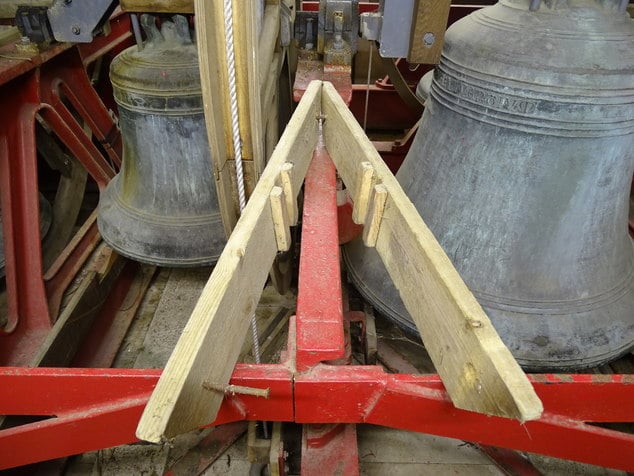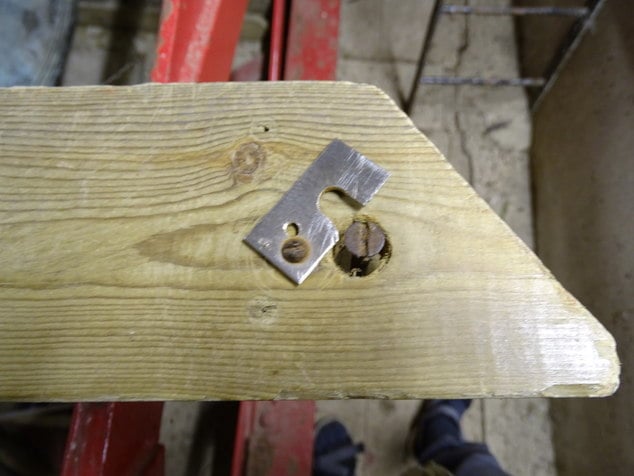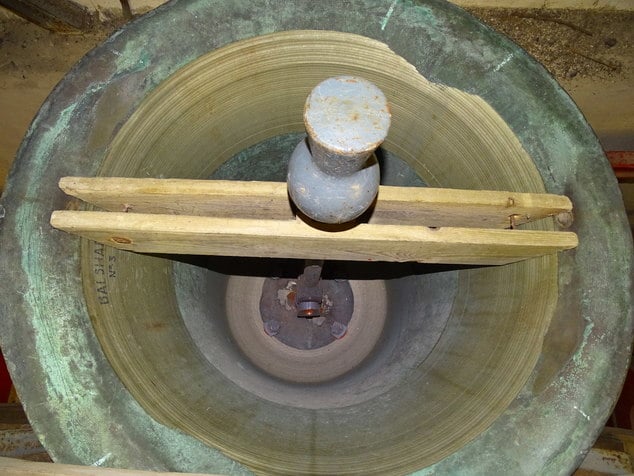Comments
-
Determined UnderachieversA happy practice night is so important. However much people enjoy technical or other aspects of ringing, they won't keep coming if the atmosphere isn't something they enjoy.
You need the support of the rest of your band. Let someone else stand behind - one of my lot, who is a midwife, was wonderful with early plain hunters (when she wasn't much more advanced than they were). She went into professional calming mode, and you could almost hear her saying 'Breathe - slowly!'
Also, we get good discussions about how different people find their way around etc. Yes, we have the awkward one who claims he can't hear, and the only way is by knowing the numbers, but there are others with different (better!) points of view, and people listen and share. And I join in and try to guide, without dominating.
Regarding practicalities, I'd use exercises to progress towards PB, as suggested by John de Overa. I find ringing 1 or 2 to Grandsire (PH with the numbers messed up - a bit) and Bayles particularly useful.
And knowing you, I doubt if you're not smiling enough (and you can never smile too much!) Nevertheless, I sense a degree of frustration. Try not to let that show. -
Mentoring SchemeThank you John. I’m pleased to say that our culture is such that feedback after a touch is normal, and a ‘significant’ issue is not needed to trigger a comment. There is an expectation of regular feedback, and we’re all looking out for each other; just nobody thinks of it as ‘mentoring’. And, of course, it’s not only feedback, but explaining stuff (theory, the next stage…) as well. It works well locally, providing there are enough people capable of providing the appropriate guidance, but I can see it would be more problematic at Association or even District level.
-
Mentoring SchemeTwo thoughts, come to mind in relation to this, suggesting that individual mentors may not be the ideal answer.
First was a recent experience training for the RoSPA advanced, driving test. I was given a very nice and entirely competent tutor who just didn’t work for me. He was far too nice, telling me how good I was, but failing to pick up on issues I needed to improve on. Fortunately I was able to change tutors, but it was not an easy situation for a while.
Second, I’m in print saying ‘take advantage, not umbrage’ with reference to other people giving advice to ‘your’ learners. The other side of that coin is that I advise my learners to listen to anything they are offered, and to make use of anything that makes sense to them. The point is that everybody’s mind works differently. My way of explaining something may not be getting through to them, but somebody else’s may work.
So, in summary, I think I’m saying that an open culture where everyone feels able to offer advice, and everyone listens to advice which is offered (not necessarily the same as accepting it!) is what we really need. It is also worth saying that in such an environment, questionable advice will quickly get picked up and debated, and that learners feel able to contribute as well. Their ’recent learner’ perspective can be particularly valuable. -
agressive teachersI’m slightly confused. Was the learner (to whom your friend was explaining place counting) ringing at the time (as I think Lucy is assuming)? If not, was your friend using the ringing that was happening to point out places? And what was the role of the person who shouted? Was he standing behind another learner? We also have no idea what this tower was like - how much space there was, and what that acoustics were like. Was the plain hunt going well at the time, or falling apart? All in all, I don’t think this forum can hope to resolve an individual issue like this (which isn’t to say that it shouldn’t be resolved elsewhere), but there are perhaps some useful takeaways.
Listening and hearing are not easy skills for most learners to acquire, and external distractions don’t help.
As Lucy says, sometimes an instruction in the heat of the moment comes out louder or more ‘aggressive’ than intended, particularly when things are suddenly falling apart. We all need to be aware of this, so that on one side we make allowances for the ‘shouter’, and on the other side, we apologise if we’ve accidentally gone over the top.
Ringing is a team exercise, where the ‘atmosphere’ really matters, and we should be alert to the need to nurture a friendly and supportive environment.
We need to be tolerant, but we also need to be prepared to call out problematic and divisive behaviour. Doing that in a way that will heal rather than further inflame a situation is a special skill, but letting things fester is rarely the right answer.
I’m conscious that things are very different in my home tower on a practice night, where we all know each other, and make allowances, by comparison with a course where a number of strangers have been brought together. Leading a training session demands skills beyond ringing. We should be particularly supportive of those who take on this role.
We’re all learning together, all the time! -
Clapper 'ties'The clapper tie I devised and have used now for about 35 years is on the EDA resources page; https://www.elyda.org.uk/education (second up from the bottom). The catch is held in place by the spring of the wood when bent a little around the clapper. A few photos attached as well.



-
Do we stop teaching people too soon?Nobody is going to learn to dodge properly with the standard 2 attempts at 2 leads of PBD a week. — John de Overa
Have you tried Bayles? (See https://ringingteachers.org/application/files/8916/1427/3217/Bayles_Bob_Doubles.pdf , although I tend to ring it ‘stand alone’ rather than spliced with PB, as both our 3rd and 4th are manageable for learners at that stage.)
Not an imposition on a practice night, and allows individual pieces of work to be practiced on their own. It is important in my view for dodges to be practiced with plain hunt each side of them. Repeated dodges just don’t have the same rhythm, or required physical actions. -
favouristism and experienced ringersI have one ringer who swears blind he can’t hear his bell amongst others, and that it takes him several goes to work out who is following him in call changes. Consequently he is very resistant to all attempts to wean him off knowing who to follow, be it through counting or rope sight. However he is the best at setting his own goals, and asking advice - for example earlier this year he came up with a set of four objectives for 2924. We then had a WhatsApp discussion about these. (Occasionally these discussions get onto the group WhatsApp, with other members of the band - some still fairly inexperienced themselves - putting in their views on what works for them.)
If there’s any risk of favouritism here, it’s for the ringer who takes charge of his own learning targets, not the quickest or best. Although I try my hardest to give each of the learners appropriate advice and opportunities all the time, I am forced to respond to the one who asks for help and advice, and the others can get inadvertently left out.
So, I think the morals of that story are for learners (aren’t we all?) to be proactive and to ask for help and opportunities, and for TCs to look out for those who don’t ask. -
Birds nesting in Towers and bell chambersAlison has the right answer here. Birds loose in the tower are a bad idea, but nest boxes with external entrances only are not a problem, and swifts need all the help we can give them.
-
UNESCO status for bell ringing?I agree that there doesn't seem to be a downside. Happy to help, but I'm a bit unclear as to how. It would help if the CC could say what they would like us to do, please.
-
Ringing Courses Value-For-Money (RW Letter)Thanks for asking.
We have been running now for six months. There are 48 ringers registered, although a few are not really active participants. Where it has been used, it has been successful - lifting a R&C / plain hunt practice to PB and Stedman for example. Of the two towers which are using it regularly one is at that level, and the other just needing support to ring R&C / plain hunt steadily, but one (8 bell tower) also requested ringers for a few practices to help them ring Kent.
Out of the 48 registered, 16 have helped at least once. I think this would be more if there were more towers using it. People are unlikely to support practices which are at the other end of the district, or on their own practice night.
Overall, the scheme has been well received, and works well, but we do need to increase uptake by practice nights.
Unfortunately you can’t see how it works properly without registering, but if you go to https://autoperry.cambridgeringing.info you can at least see the help pages, which include information on the source code, for those who understand that. If anyone is serious about seeing more, please let me know at pnsoatcambridgeringingdotinfo. -
Right Hand TransferIf you stop your handstroke pull short, the rope will be at an awkward angle for your upper hand to get round. If you make sure you follow right down into your lap as you come off the sally, it’s much easier.
-
Grooves in tower archesBut, this would have been a long way up before the ringing floor was installed, and the grooves bear a marked similarity to those which can be seen on canal bridges, caused by tow ropes.
-
Drying units for ropesI find that a low energy light bulb (the old sort that takes ages to warm up, not LED) gives enough heat to be useful. Just an hour a day on a timer keeps the tail ends pliant. https://www.facebook.com/BalshamBellRingers/photos/a.160760561488906/715801599318130/
-
President's Blog #76A positive cornucopia of ideas! Two minor comments:
First, the Loughborough Bell Foundry link takes me to their page, but with a '404' error.
Second, as I got further down, the fact that going to a link and then returning always took me to the top of the page (rather than where I had left off) became increasingly more irritating! Right clicking, and then opening in a new tab overcomes that problem. -
Novice with aching handsI also note Martin's comment immediately above. I find the reasons for right hand on top vs left hand on top fairly weak, so I always let my learners choose at the outset (I get them to put their hands up on a rope, without saying why, and see what comes naturally.) If they choose left hand on top, I then check whether RH on top feels wrong. If it does, I let them continue with LH on top, as I don't want them to have to un-learn their natural inclination, on top of learning bell handling. I fear that your lady might have real problems un-learning, and I don't think that's where I would start.
-
Last coil in raisingWhen raising I tell people to relax the grip completely on the up stroke so the rope, and only to grip and pull at the top of the stroke when they can feel the bell has stopped rising — John Harrison
As John says, if in their eagerness to get a good pull, they pull even slightly too soon, it is counter-productive, and stops the bell from rising. — Phil Gay
And then there's the issue of getting (and keeping) the bell chiming at the start (tricky with most of ours which are in canon retaining headstocks). This requires a fine balance between checking and pulling, and a good feel for when the bell is about to turn round at the top, and then in addition, judgement and control of how much to follow up the check (for chiming) with a pull. Any ideas on how to get this across most welcome! -
Last coil in raisingAgreed - the coils need to be carefully placed to start with, and reasons explained. However, even if the coils are laid up correctly, the tail can get tucked under the last coil, and be reluctant to drop out. Which is where I started - if your grip is really loose and relaxed at that point, it does slip out easily, even if it's not quite where you planned for it to be.
-
Ringing with arthritisMy sister commented as follows:
"I have both rheumatoid and osteo arthritis affecting my hands and other joints. I find the most important thing is to pace yourself. At the time it may seem fine to ring several times without a break, but you risk paying for it the next day(s). It's difficult in our tower as we hardly ever have enough ringers to take turns, but I've learnt to insist, so we have breaks and if necessary, shorten the practice sessions. I also refrain from ringing up and stick to the lighter bells. I find that rubbing in a bit of glycerin improves grip, so you don't have to grasp the rope so tightly, but some towers don't like that. I also tuck the end of the rope into a wristband (the stretchy cotton kind that sportspeople use). This is because I'm tall so I always have a long tail end which I hate having whisking around, but it does also give a degree of confidence if your grip is weak. Some folk say it's dangerous, but the rope would pull out in an emergency, and the worst you could suffer would be a rope burn." -
Dwindling tradition, weird hobby or join a friendly band?"We don't have much luck with direct advertising, personal contact is best, but continued involvement in the community and drip feeding people with information about our ringing helps maintain awareness." This is exactly our experience. Regular posting on the Village Facebook page, ringing for events, demo at the local village festival, articles in the parish magazine, throwing teddy bears (with parachutes!) off the church tower... We get lots of positive reaction, and the occasional recruit. People still need to be pushed over the threshold from 'positive reaction' to 'recruit' though, and that's where the personal contact comes in. All the band need to be involved, at least in a village setting.
Richard Pargeter

Start FollowingSend a Message
- Contact Us
- RingingForums Policy
- Terms of Service
- Useful Hints and Tips
- Sign In
- © 2025 Ringing Forums


